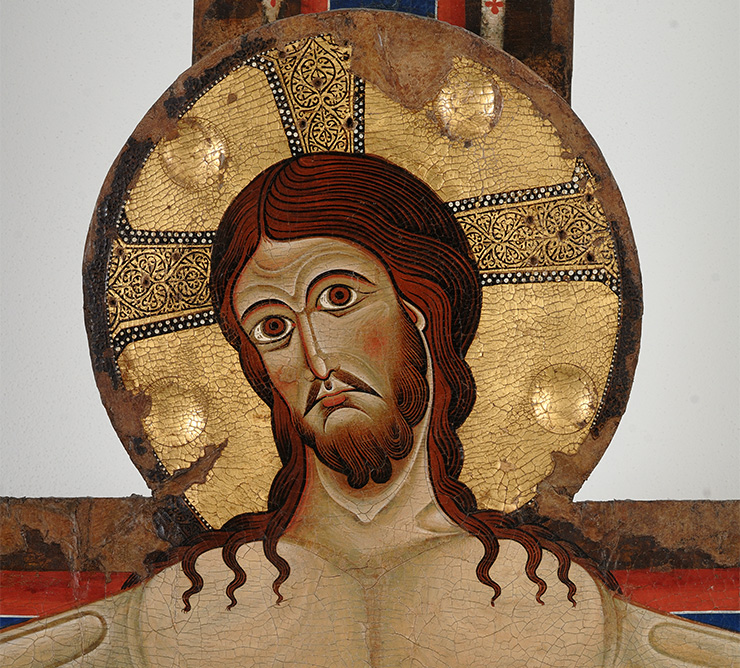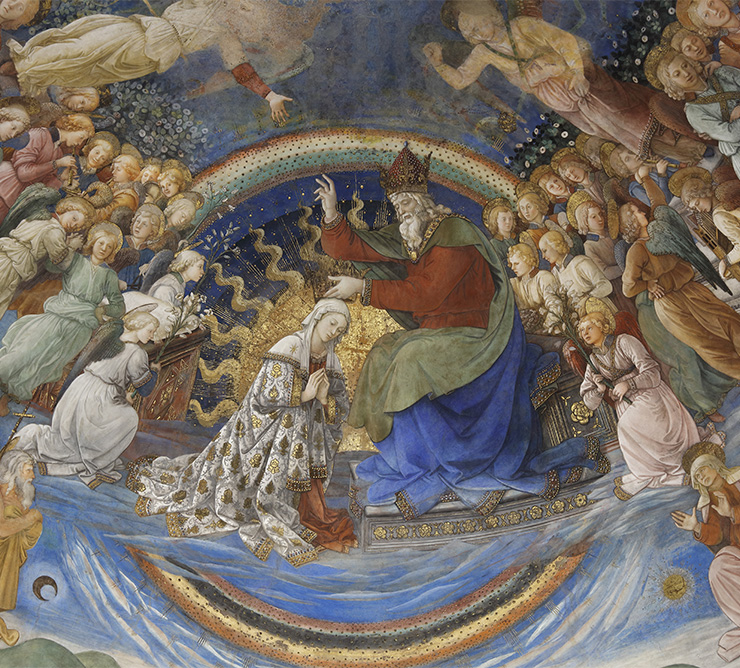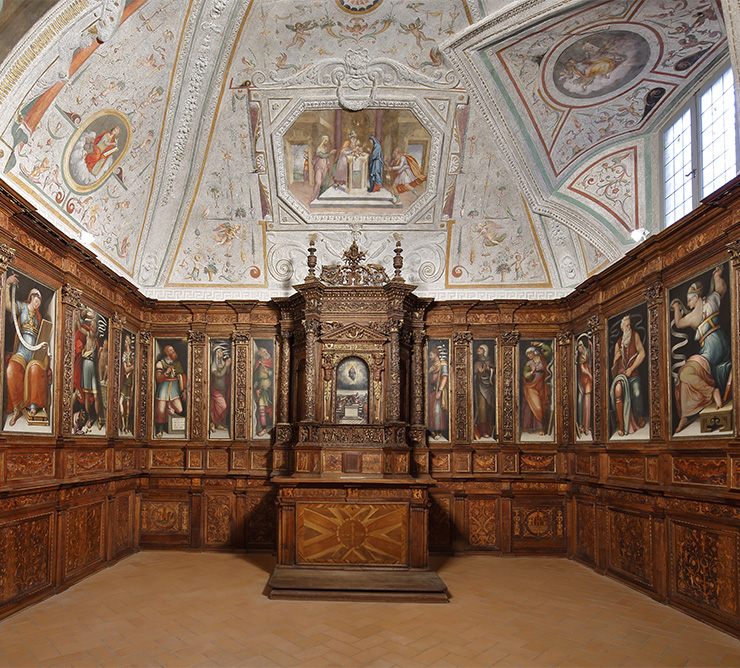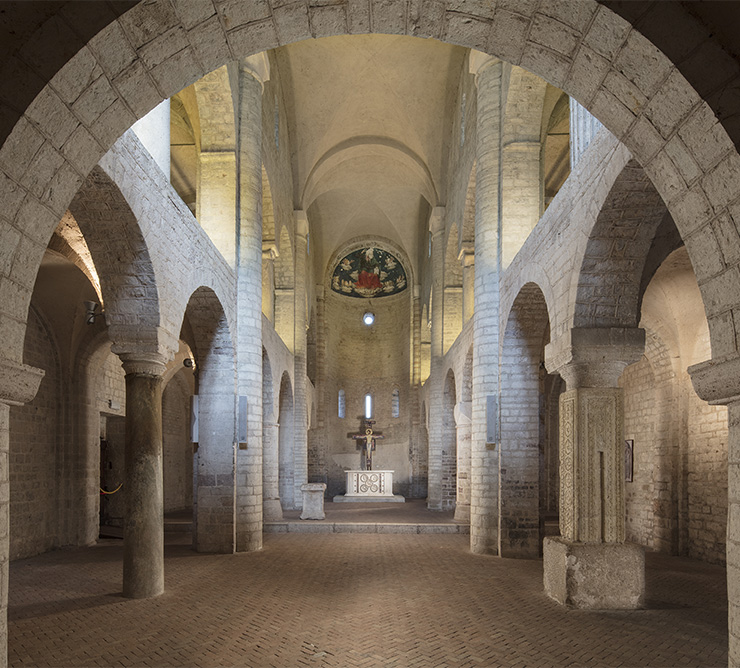An unusual tour planned to admire the paintings in the Cathedral apse, the romanic Basilica of St. Euphemia and the Diocesan Museum with the exclusive opportunity to walk up the ancient Bell Tower, which is actually still working, and to admire the city from above. The tour begins from the right side of the Cathedral, the Eroli Chapel, Bishops of Spoleto, dedicated to the Assumption and with paintings by Jacopo Siculo depicting Prophets and scenes from the Old and New Testament.
The tour is available from 26 March to 1st November.
You'll be ideally received by the Virgin Mary of the Assumption venerated by Bishop Eroli and to whom the Cathedral is dedicated. The visit brings you to the frescoes by Filippo Lippi in the apse, again on a theme of the Assumption, the culmination of the aesth... more
You'll be ideally received by the Virgin Mary of the Assumption venerated by Bishop Eroli and to whom the Cathedral is dedicated. The visit brings you to the frescoes by Filippo Lippi in the apse, again on a theme of the Assumption, the culmination of the aesthetic and religious itinerary. The church also contains various masterpieces: from the facade to the floor, through styles and schools, from early art to Romanesque, Renaissance, Baroque and Neoclassicism. However, the Cathedral is'nt only a place of monuments, it's also a place of spirituality, especially the Relics' Chapel, where the precious autograph letter from St Francis of Assisi to Brother Leo is kept. We find, in addition, the Chapel of the Holy Icon, built in 1626 in place of the old sacristy to house the Byzantine tablet donated to the city by Federico Barbarossa in 1185 as a sign of reconciliation, and in which the Virgin Mary holds a scroll, which although not currently legible because the icon is covered with a gold riza, contains a moving dialogue between the Son and the Mother:
- What do you ask for, O Mary?
- The humanity's salvation.
- But they cause outrage.
- Pity them, my Son.
- But they are unconverted!
- And you save them by grace.
The icon is traditionally attributed to St. Luke and most probably came to Italy during the iconoclastic controversy in the East in the 8th-9th century. Related to the 'Holy Icon' is, also, the conversion of the young Francesco Possenti (San Gabriele dell'Addolorata).
In addition to visiting the Cathedral, it's possible to continue on to the Diocesan Museum and the St Euphemia Basilica. The Museum, located inside the Palace of the Archiepiscopal Curia, contains works from early art to the Renaissance up to the Baroque: masters from Spoleto, Florence and Rome, from the author of the Blue Cross to the Master of San Felice di Giano, from Neri di Bicci to Filippino Lippi, from Domenico Beccafumi to Cavalier d'Arpino and Gian Lorenzo Bernini.
From 26 March to 1st November:
By train:
Direct connections from Rome via Orte, in 1h20 via 5 Eurostar trains and about 1h45 via 12 Regional trains. From Milan, 6h10 on Intercity and 5h15 via Florence on the Freccia Rossa. Other journey times (approximately): 4h Bologna, Florence 3h15, Naples 3h, Turin 8h30, Venice 6h45.
By plane:
The nearest airport is Perugia's 'San Francesco d'Assisi' airport, with daily flights to Milan Malpensa and with variable frequency to London and Tirana. Connections to Spoleto are possible by taxi and car hire. The best alternative is Rome Fiumicino, with a transfer to Spoleto by train (via Leonardo Express to Roma Termini).
By car:
Arriving from the south, Spoleto is 60 km from the Orte exit of the A1: continue on the SS3 Flaminia towards Terni and the SS395 towards Foligno. The distance from Rome is about 150 kilometres. Coming from the north, you can exit the A1 motorway at Valdichiana and continue on the E45 in the direction of Foligno, then the SS75 and SS3, for a total of about 115 kilometres. The distance from Milan is approximately 510 kilometres. Private vehicles are not allowed in the centre of Spoleto. Several parking areas are available nearby, with prices ranging from 0.50 € per hour to 40 € per month. Information on: Umbria Mobility Average journey times: Ancona - Spoleto: 2h 05m - 155 km Florence - Spoleto: 2h 15m - 210 km Rome - Spoleto: 1h 50m - 145 km Naples - Spoleto: 3h 22m - 330 km Milan - Spoleto: 5h 05m - 510 km
By bus:
Spoleto is served by local bus lines, and from other towns in Umbria. Information on: Umbria Mobility.

Along the right aisle, on the last altar before the transept, is the famous painted Cross by Alberto Sotio dated and signed 1187. It was made for the Spoleto church of Saints John and Paul, where it remained until 1877, when it was transferred to the Cathedral of Santa Maria Assunta. The Cross, painted on parchment applied to the panel, presents Christ in the type of the Triumphans: upright and with his eyes open, as he has symbolically already conquered death. In the side compartments one recognises the two mourners: the Virgin Mary and St. John the Evangelist, while in the suppedaneum the blood runs down from Jesus' feet to Adam's skull at the base of Mount Calvary. In the lower part of the Crucifix we find the date and signature of Sotio.

The Cathedral apse features an extraordinary fresco decoration with Stories from the Life of the Virgin by the Florentine artist Filippo Lippi, who died in Spoleto in October 1469 and is buried inside the Cathedral itself. The Spoleto cycle is his last work: he died before the frescoes were fully completed. On the back wall, in the curve of the apse, divided by painted pilasters, we recognise the Annunciation on the left, the Death of the Virgin in the centre and the Nativity on the right; in the apse basin we find the Coronation of the Virgin in the presence of Angels and Saints. In the Annunciation, Mary, seated inside a portico, turns shyly towards the Angel outside in front of the portico who, kneeling complacently on a floor with marble inlays, holds a lily in his hand; God the Father, supported by clouds and enveloped in rainbow light, sends the Holy Spirit into the Virgin's womb. Recognisable in Mary's likeness is Lucrezia Buti, the woman loved by Filippo and mother of his son Filippino, who from the fifties of the 15th century gave her face to numerous female figures painted by Lippi. The central part depicts the Death of the Virgin Mary: a group of angels and saints attend the funeral of the Virgin Mary lying on her deathbed. In the group we recognise the painter himself, dressed in Carmelite robes, flanked by other figures, perhaps his collaborators, and his young son Filippino Lippi, who began his apprenticeship in Spoleto. On the right, in front of the hut leaning against the ruins of a palace, is the Nativity scene in which the Child Jesus is humbly leaning on the ground. On the right, in the background, the annunciation to the Shepherds is depicted. In the centre of the apsidal basin, on a brilliant blue background and within a disc of light, is the Coronation of the Virgin: the celestial group is surrounded by the angelic hierarchies, as well as the Patriarchs, Prophets, Sibyls and Old Testament heroines.

This chapel houses the autograph letter of St Francis to Brother Leo, a document dated 1224. Originally preserved in the church of San Simone in Spoleto, it is written on a small goatskin parchment. It is one of the two letters written by the saint and recognised by scholars as autograph, and therefore of extremely rare and priceless historical and religious value. Francis is addressing Leo, one of the most assiduous and faithful friars, buried next to him in the basement of the Basilica of Assisi: a tone of moving fraternitas emerges in Francis' words.

The St. Euphemia Church is one of the most remarkable Romanesque buildings in Umbria. Its origins remain uncertain: according to the most accredited hypothesis, it stands on the area that was once occupied by the palatium when Spoleto was under the rule of the Lombards, who elected the city as their ducal seat. The basilica would therefore be the evolution of the palatine chapel of the Lombard dukes dedicated to St Euphemia herself. In the 10th century, a monastery of Benedictine nuns was added to the church; the gallery above the nave of the church is all that remains of the space used by the nuns during the officiating services. The interior, divided into three naves with alternating columns and pillars, seems to recall the Lombard Romanesque style. At the end of the nave, one can admire a beautiful marble altar originally placed in the Cathedral decorated with cosmatesque motifs and featuring five reliefs with symbols of the Evangelists and the Mystic Lamb.